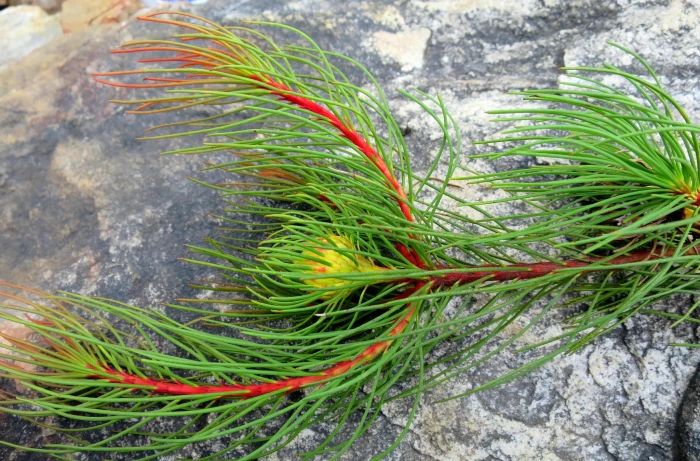Channel-Leaf Featherbush
(Aulax cancellata)
Channel-Leaf Featherbush (Aulax cancellata)
/
/

Di Turner
Public Domain
Image By:
Di Turner
Recorded By:
Copyright:
Public Domain
Copyright Notice:
Photo by: Di Turner | License Type: Public Domain | License URL: http://creativecommons.org/publicdomain/zero/1.0/ | Rights Holder: Di Turner | Publisher: iNaturalist | Date Created: 42449 |














Estimated Native Range
Climate Requirements for Alexandria, Virginia
| This Plant | Your Site | Plant Suitability for Your Location | ||
|---|---|---|---|---|
| • Precipitation | 12" - 59" | 41" | Aquatic | Aquatic |
| • High Temp. | 70°F - 86°F | 88°F | Your summers may be too hot for this plant. | Too hot |
| • Low Temp. | 33°F - 49°F | 25°F | Your winter temperatures may be too cold for this plant | Too cold |
This plant may not grow well at your location - your precipitation is too high.
Summary
Aulax cancellata, commonly known as Channel-Leaf Featherbush, is an evergreen shrub native to the fynbos biome of Southwestern and Southern South Africa. This unique ecosystem is characterized by Mediterranean-type climate with wet winters and dry summers, and the plant is adapted to these conditions. Aulax cancellata typically exhibits an upright growth habit with a single stem and can reach up to 2.5 meters in height. The species is dioecious, meaning individual plants are either male or female, with male and female flowers occurring on separate plants. The plant blooms in spring and summer, producing yellow flowers that are not particularly showy but are interesting for their feathery appearance.
Channel-Leaf Featherbush is valued for its attractive, fine-textured foliage and its adaptability to low-water landscapes, making it suitable for xeriscaping and Mediterranean gardens. It thrives in full sun and requires minimal water once established, preferring soils with medium to fast drainage. Pollination is facilitated by a variety of insects, and after pollination, female flowers develop into a woody shell that protects the seeds. This adaptation is part of a survival strategy in its fire-prone native habitat, where the plant dies in wildfires but the seeds are released to germinate in the nutrient-rich ash. Aulax cancellata is not commonly known to suffer from major diseases or pests, but it is not frost-tolerant and can be damaged by cold temperatures.CC BY-SA 4.0
Channel-Leaf Featherbush is valued for its attractive, fine-textured foliage and its adaptability to low-water landscapes, making it suitable for xeriscaping and Mediterranean gardens. It thrives in full sun and requires minimal water once established, preferring soils with medium to fast drainage. Pollination is facilitated by a variety of insects, and after pollination, female flowers develop into a woody shell that protects the seeds. This adaptation is part of a survival strategy in its fire-prone native habitat, where the plant dies in wildfires but the seeds are released to germinate in the nutrient-rich ash. Aulax cancellata is not commonly known to suffer from major diseases or pests, but it is not frost-tolerant and can be damaged by cold temperatures.CC BY-SA 4.0
Plant Description
- Plant Type: Shrub
- Height: 6-7.5 feet
- Width: 3-5 feet
- Growth Rate: Moderate
- Flower Color: Yellow
- Flowering Season: Spring, Summer
- Leaf Retention: Evergreen
Growth Requirements
- Sun: Full Sun
- Water: Low
- Drainage: Medium, Fast
Common Uses
Drought Tolerant, Low Maintenance, Showy Flowers
Natural Habitat
Fynbos biome of Southwestern and Southern South Africa
Other Names
Common Names:
Scientific Names: Aulax cancellata, Aulax pinifolia, Protea pinifolia, Leucadendron cancellatum
GBIF Accepted Name: Aulax cancellata (L.) Druce